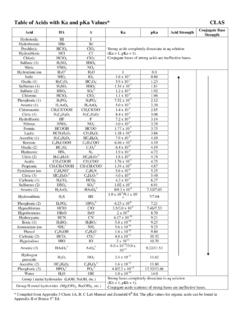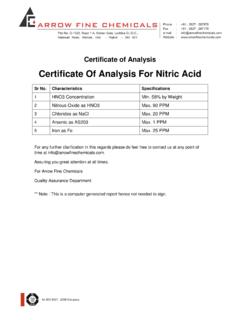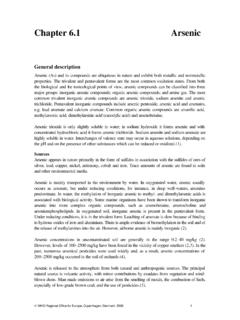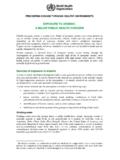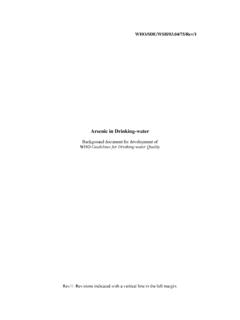Transcription of A Visual Method for the Detection of Arsenic 0 to …
1 A Visual Method for the Detection of Arsenic 0 to 500 g/L By Dan Kroll R&D Chemist. Hach Co., Loveland Colorado Introduction: Arsenic is a common contaminant of ground water that has been found to ad-versely effect human health at levels as low as 10 g/L. The current USEPA maximum contaminant level (MCL) for Arsenic is 50 g/L, however; the MCL is being consid-ered for revision to between 5 and 20 g/L. The current World Health Organization (WHO) recommended MCL for Arsenic in drinking water is 10 g/L. The quantifica-tion of trace amounts of Arsenic in water samples has always been problematic. Cur-rent methods rely on expensive apparatus, complicated procedures, and dangerous chemical reagents.
2 Lower cost test kit-type systems have been available in the past, but they only had a working range of 100 to 3000 g/L, which is not sensitive enough to monitor drinking water supplies. The new Hach Arsenic Kit addresses many of the problems associated with other methods . Summary of the New Method : Hydrogen sulfide is first oxidized to sul-fate to prevent interference, and the oxidiz-ing environment is then neutralized. Sul-famic acid and powdered zinc react to create strong reducing conditions in which inor-ganic Arsenic is reduced to arsine gas (AsH3). The arsine gas then reacts with mercuric bromide impregnated test paper to form mixed Arsenic /mercury halogenides ( AsH2 HgBr). These compounds dis-color the test strip depending upon the con-centration of the Arsenic in the sample.
3 The color change is from white to yellow to tan to brown. Reducing Chemical Hazards: Most tests for Arsenic , including the Hach Method , rely on the conversion of ar-senic to arsine gas. As2O3 + 6 Zn + 12 HCl 2 AsH3 + 6 ZnCl2 + 3 H2O H3 AsO4 + 4 Zn + 8 HCl AsH3 + 4 ZnCl2 + 4H2O The liberated arsine gas is then reacted with a detector paper that has been impregnated with mercuric bromide. As the reaction above indicates arsine gas is commonly generated by reduction with zinc metal and hydrochloric acid. Hy-drochloric acid is dangerous and difficult to work with. The Hach Method substitutes a solid acid (sulfamic) packaged in a granular powder form for the hydrochloric.
4 This al-leviates the hazards and difficulties associ-ated with using Liquid hydrochloric acid. The zinc powder and all other reagents in the Hach Method are packaged in unit dose form for convenience and to minimize han-dling. The mercuric bromide test paper is on the end of a long plastic strip to eliminate the need to come into contact with the mer-curic bromide. Another concern in Arsenic testing is the generation of toxic arsine gas. The unique design of the cap for Hach s reaction vessel focuses the arsine gas on a very small sur-face. The test strip is held in position so the generated arsine is forced to react with the test strip. A x mercuric bromide coated reaction pad is used as the indicator in the test, but the exposed hole is only 3/16 inch in diameter.
5 This arrangement allows all of the generated gas to come into contact with the mercuric bromide and be reacted. The excess paper around the hole provides sufficient reactant to absorb all of the gener-ated arsine. This increases the sensitivity of the test pad and at the same time reduces the exposure of the operator to arsine gas. 1A Visual Method for the Detection of Arsenic 0 to 500 g/L By Dan Kroll R&D Chemist. Hach Co., Loveland Colorado Reaction Vessel with Cap and Strip Test strip exposed to 500 g/L Arsenic To verify that arsine exposure is in fact minimized the following experiment was conducted. The ability of the Hach apparatus to absorb all of the arsine was compared to a currently available test kit.
6 The system be-low was used to make the comparison. System for Checking Arsine Emissions The dragger tube is a Detection system that is used to measure arsine in air. The length that a purple color travels up the tube quanti-ties the amount of arsine present. Samples containing 500 g/L Arsenic were tested us-ing both methods . The Hach Method uses a 50 mL sample and the competitor uses a 5 mL sample. The vacuum pump was set at 20 inches of Hg and allowed to run continually for the full 30 minutes of each test. The re-sults of the experiment are in the table be-low. Results of Arsine Exposure Test Apparatus mg/L AsH3 after 30 with no test strip ppm Competitor with test strip ppm Hach with no test strip > ppm Hach with test strip ppm The new Hach apparatus does a good job of preventing release of arsine to the atmos-phere where an operator could be exposed even though, as a whole it generates more arsine due to the larger sample volume.
7 Improved Sensitivity: The unique design of the cap for Hach s reaction vessel focuses the arsine gas on a very small surface. The test strip is held in position so the generated arsine is forced to react with the test strip before it can exit the reaction vessel. This combined with the large (50 mL) sample size allows for a cali-brated range of 0 to 500 g/L (ppb). The calibration scale is graduated at 0, 10, 30, 50, 70, 300, and 500 g/L. Each step is dis-tinct and allows for quantification at the lev-els needed to ensure health and safety stan-dards. AirInAsH3 Gen. Vial ThreadedCapDragger Tube PVC Cylinder 20 Vacuum Pump at 20 Inches Hg 2A Visual Method for the Detection of Arsenic 0 to 500 g/L By Dan Kroll R&D Chemist.
8 Hach Co., Loveland Colorado Sulfide Interference: Unfortunately, in the reduction of arse-nic to arsine gas, sulfides are also reduced concurrently with the Arsenic to form hydro-gen sulfide (H2S). Hydrogen sulfide also reacts with the mercuric bromide test paper. The current methods of removing sulfide interference entail passing the arsine gas stream through a scrubber to remove the hy-drogen sulfide. These scrubbers are usually cotton soaked in lead acetate solution (zinc and copper have also been utilized but have been found to be less efficient). The sulfide reacts with the lead on the cotton to form solid lead sulfide, thus effectively removing the sulfide contaminant from the arsine gas stream.
9 There are two major drawbacks to this Method . First, it is difficult to ensure that a tight seal has been formed that will obligate the passage of all of the gas through the scrubber. The rate of gas evolution must also be controlled to allow adequate contact time for all of the sulfide to react. Secondly, the operator is forced to handle hazardous lead acetate and lead sulfide, and after the test is over, there remains the problem of disposing of these toxic materials. Hach s new Method eliminates the need to rely on hazardous lead acetate to remove sulfide interference. The patent pending Hach Method employs the addition of 3 unit dose reagent pillows to convert the sulfide present in the sample to a form that will not interfere in the test.
10 This is done without hazardous chemicals such as lead acetate. First, sodium phosphate dibasic and po-tassium monopersulfate (Oxone ) are added to the sample. This results in formation of strong oxidizing conditions. Sulfides are oxidized under these conditions to sulfate in which form they no longer interfere with the Arsenic test. Next a mixture of disodium and tetrasodium EDTA is added to the sam-ple to remove any residual Oxone that could interfere in the subsequent reduction and evolution of arsine gas. Tests were run to determine the quanti-ties of sulfide that could be tolerated by this Method . A sulfide concentration was said to interfere if the color developed in the Arsenic test exceeded more than of the step be-tween 0 and 10 g/L Arsenic on the color chart or approximately 5 g/L Arsenic .
